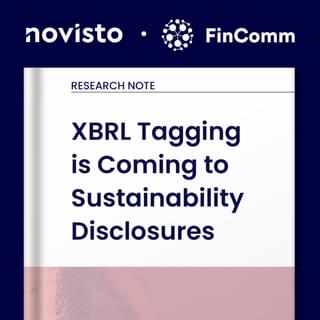
XBRL has revolutionized financial disclosures by ensuring consistency, comparability, and accessibility of data worldwide. Now, it’s making its way into sustainability reporting. With regulations like the CSRD driving adoption, XBRL is set to harmonize sustainability and financial reporting, enhancing transparency and making ESG data more useful and impactful for stakeholders.
What is XBRL?
XBRL, or eXtensible Business Reporting Language, is a reporting digitization standard developed in 1998 for financial information. Integral for structuring and exchanging business data, it uses machine-readable formats, moving beyond traditional paper or PDF reports that are only readable by humans.
A cornerstone of financial reporting
In financial reporting, XBRL is a universal language for tagging information to ensure consistency and comparability. This has revolutionized how financial data is understood and analyzed, making it easier to compare reports from different issuers.
Digital and XBRL-tagged financial disclosures are already mandatory in key markets like the U.S., China, the EU, Japan, India, and the UK, covering over 90% of global market capitalization. But adoption isn’t universal. In countries like Canada, Australia, and New Zealand, where tagging is voluntary, uptake has been minimal.
What are XBRL tags?
Reports filed in XBRL format use a taxonomy—a set of terms that digitally represent disclosure rules. These terms are applied as tags to a company’s reported data, along with metadata like time period, source, date, and units. This allows machines to read the data and its context without human intervention.
iXBRL or XBRL?
iXBRL (Inline XBRL) combines the machine-readability of XBRL with human-readability by embedding XBRL tags into HTML documents. While XBRL files are purely machine-readable, iXBRL allows data to be both extracted by machines and easily viewed by humans in a web browser.
Knowing the difference between iXBRL and XBRL is crucial as digital reporting evolves. iXBRL ensures transparency and accessibility, empowering both human reviewers and automated systems to work more efficiently with the same data.
Why is XBRL important?
Digitized and XBRL-tagged corporate disclosures are transforming the way capital market participants—companies, investors, data aggregators, and regulators—access and use business information. By making disclosures machine-readable, XBRL improves the discoverability, comparability, and usability of data. As XBRL International puts it: “XBRL is the global standard that powers digital reporting. By making business reporting computer-readable, it helps make business data easy to find, access, and analyse.”
Moreover, XBRL tagging enhances transparency in corporate reporting by streamlining how financial and sustainability data is identified, captured, and analyzed. According to Deloitte, it facilitates continuous auditing, strengthens the enforcement of corporate accountability legislation, and increases efficiency across the entire information supply chain.
“XBRL is the global standard that powers digital reporting. By making business reporting computer-readable, it helps make business data easy to find, access, and analyse.”
- XBRL International
What are the benefits of XBRL tagging?
Digitized and XBRL-tagged disclosures bring significant advantages to capital market participants—companies, investors, data aggregators, and even regulators. How? By making ‘as reported’ information easier to access, analyze, and use. Simply put, XBRL tagging transforms corporate data into a more discoverable and actionable format.
While companies bear most of the costs associated with XBRL tagging, they also reap significant benefits, including :
- Enhanced data quality: XBRL tagging helps companies implement reporting standards properly and ensures their disclosures are both comparable and accurately interpreted by humans and machines.
- Investor appeal: At the market level, being more easily discoverable may increase companies’ access to capital by diversifying their investor base and facilitating their access to foreign investors.
- Streamlined peer benchmarking: With standardized and comparable data, companies can conduct peer benchmarking more efficiently and accurately, unlocking better insights for strategic decision-making.
From finance to sustainability: The next frontier
Building on the foundation set by financial disclosures, sustainability disclosures are quickly following suit. Driven by regulatory mandates and the increasing integration of financial and sustainability reporting, the push toward XBRL tagging for ESG data is gaining momentum.
XBRL & the CSRD
The EU’s Corporate Sustainability Reporting Directive (CSRD) requires companies to provide their sustainability information in a digitized and XBRL-tagged format, which will be accessible via the upcoming European Single Access Platform (ESAP). Additionally, the directive requires external assurance of compliance, including checks on the use of the Single Electronic Reporting Format (Article 29d).
EFRAG has already published the European Sustainability Reporting Standards (ESRS) Set 1 XBRL taxonomy, with the next step being the European Commission’s formal adoption via a delegated act. This taxonomy includes a set of XBRL elements, or “tags,” that align with the structure of the ESRS standards, covering both cross-cutting and topical ESG standards. Once finalized, companies will be required to tag sustainability statements and submit them in XHTML format.
The ultimate goal is to make disclosures widely shareable, ensuring they are easily accessible and usable by stakeholders across the board.
Key takeaway: Under the CSRD, in-scope companies must produce digital, XBRL-tagged sustainability reports in a standardized format, replacing traditional PDFs or paper reports. These reports must comply with the ESRS XBRL taxonomy, ensuring they are both human- and machine-readable. |
Challenges of XBRL tagging under the CSRD
The XBRL tagging process under the CSRD poses significant challenges for organizations. It’s time-consuming, highly error-prone, and requires deep proficiency with the ESRS taxonomy and its complex requirements. For instance, the ESRS includes over 200 mandatory data points, each needing precise tagging, corresponding metadata (such as duration and entities), and strict accuracy to avoid mistakes like mistagging or missing tags entirely.
Summary of key challenges:
- Manual and error-prone: Tagging is a detailed, manual process prone to mistakes like forgetting tags, mismatching metadata, or using incorrect tags, all of which can complicate assurance reviews.
- Qualitative data: Unlike financial data, much of ESG information is qualitative or narrative-driven, making it more complex to structure and tag.
- Lack of familiarity: Teams unfamiliar with XBRL concepts like dimensions, taxonomies, and references may find the process daunting and difficult to navigate.
- Time-consuming: In-house tagging requires significant time investment, including training on XBRL tools and taxonomies, diverting resources from other priorities.
- Costly outsourcing: Engaging third-party consultants for tagging can be expensive, placing additional financial strain on organizations.
How ESG software supports CSRD XBRL tagging
ESG data management and reporting software offers a practical, efficient solution to help organizations comply with the CSRD’s XBRL tagging requirements. By streamlining the tagging process, ESG software reduces errors, accelerates timelines, and lightens the reporting burden on sustainability teams, making compliance more achievable.
Key benefits include:
- Enhanced data quality: ESG software ensures consistent and accurate tagging by applying standardized data points. This reduces manual entry errors, eliminates discrepancies, and improves the overall reliability of sustainability disclosures.
- External assurance is simplified: ESG software with XBRL tagging directly supports auditing by creating a standardized, verifiable data trail. This automation not only ensures accuracy in sustainability reporting but also significantly reduces audit time and costs, making the entire process more efficient and reliable.
- Significant time savings: ESG software removes the steep learning curve of mastering technical XBRL taxonomy requirements for the ESRS. It significantly reduces the time and stress associated with tagging, freeing sustainability teams to focus on more strategic priorities.
Navigate the CSRD with Novisto
With Novisto’s ESG data management and reporting software, companies can confidently navigate the complexities of the CSRD’s XBRL requirements. Novisto connects over 2,000 metrics to XBRL tags, making sustainability reports both human- and machine-readable. In addition to full XBRL tagging for the ESRS, we also support double materiality assessments to enhance your CSRD readiness. Feel free to explore our CSRD Solution Overview for more information.
Go further
XBRL tagging is enhancing sustainability reporting by improving transparency, consistency, and accessibility. As the reporting landscape evolves, understanding the role of XBRL is essential for navigating regulatory requirements and improving the quality of your sustainability data.
Ready to dive deeper into XBRL? Explore practical insights, best practices, and strategies for success in our comprehensive research note on XBRL Tagging.


